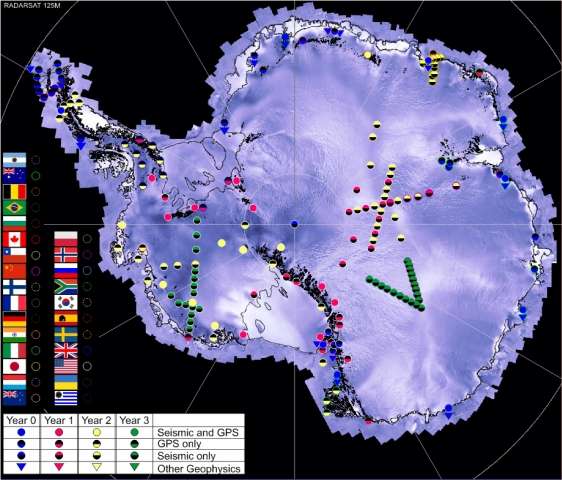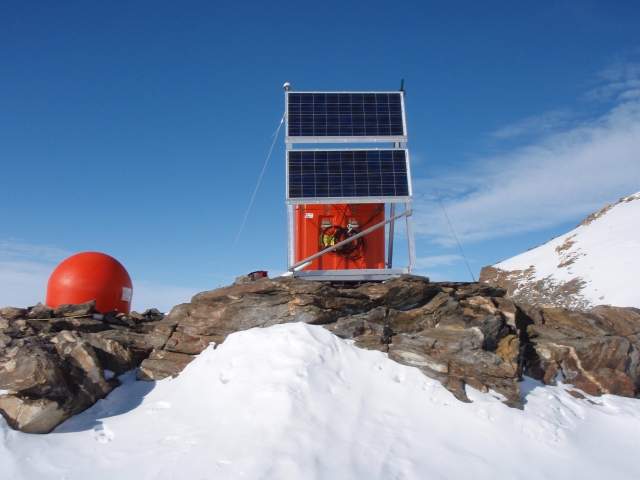POLENET
POLENET Project

The Polar Earth Observing Network (POLENET) is a large international, multidisciplinary project which is a core activity of the International Polar Year (IPY) 2007-2009. The project combines Seismic and GPS instrumentation at remote sites in Antarctica. The data collected during the POLENET experiment will enable new studies of the inner earth, tectonic plates, climate, and weather. U.S. POLENET projects are supported by the National Science Foundation. PASSCAL supports the U.S. seismic portion of POLENET by providing specialized cold-hardened, equipment, field support, and training for University based field teams.
Field Area
The seismic portion of the POLENET experiment consists of 23 backbone stations installed along the Trans Antarctic Mountains (TAM) and on the West Antarctic Ice Sheet (WAIS) as well as a 13 element transect based near Byrd surface camp.

Logistics
The seismic stations used in the POLENET deployment can be installed by a 3 member team in less than 4 hours. The station weighs approximately 1100 pounds and can usually be transported in one Twin Otter flight, depending on the distance from base camp to the desired site. When longer distances need to be covered, a Basler (modified DC-3) has been used. When a POLENET station is to have co-located GPS and seismic instrumentation, it has been common practice to cache the equipment at the desired site, and send GPS and seismic installation teams to the site together.
Equipment
The equipment for the POLENET project was developed with MRI funding for the development of cold hardened power and communication systems. This 3 year project has produced easily deployed, highly effective seismic stations that are tollerant of the harsh Antarctic conditions while providing year round power, data recording, and state of health (SOH) communications.
- Digitizer
- Cold Rated Quanterra Q300
- Media
- Cold rated Quanterra PB14F packet baler, 16GB indusrial flash memory
- Seismometer
- Nanometrics Trillium 240
- Cold rated Guralp CMG-3T
- Power System
- PASSCAL Power Management Module (PMM)
- Genasun GV9 Charge controller
- UAF power switching board
- Mil-spec connections for batteries, solar, heat, and loads
- 8x Concorde 1080T AGM batteries
- 2x Sharp 80 Watt solar panels mounted to rugged aluminum frame
- PASSCAL Power Management Module (PMM)
- Communications
- Xeos XI-100 Iridium
- Insulated Station Enclosure
- Hardigg AL3434-2807 roto-molded enclosure
- 1" Vacuum insulation panels (VIP)

Project Report
This is an ongoing project currently scheduled for 6 field seasons. With 2 seasons completed there are 14 backbone stations installed, 10 during the first field season and 4 during the second. During the second season 5 stations were serviced and 95% of expected annual data was recovered. The third and next field season is quite ambitious with a planned service of 14 stations, installation of 13 transect stations, and the installation of the remaining 9 backbone stations.
Reference:
POLENET, http://polenet.org/
- Home
- General Information
- Instrumentation
- Dataloggers
- Sensors
- All-In-One Systems
- Power Systems
- Field Procedures
- Controlled Sources
- Seismic Source Facility
- Magnetotelluric Systems at PASSCAL
- Ground Penetrating Radar
- Power and Memory Calculations Form
- Data Archiving
- Apply for a PI Account
- Experiment Scheduling
- Polar
- Important Hardware/Software Notes
- USArray
- Software


